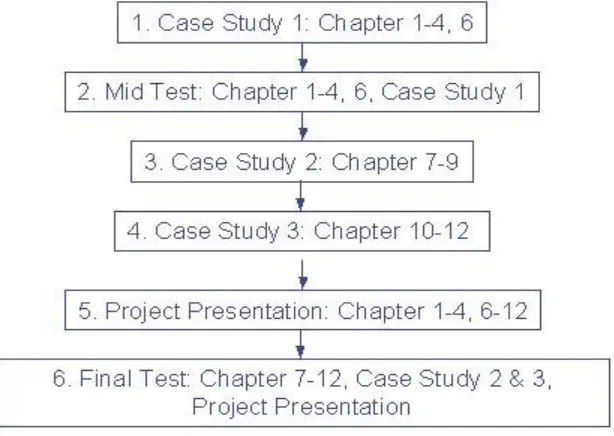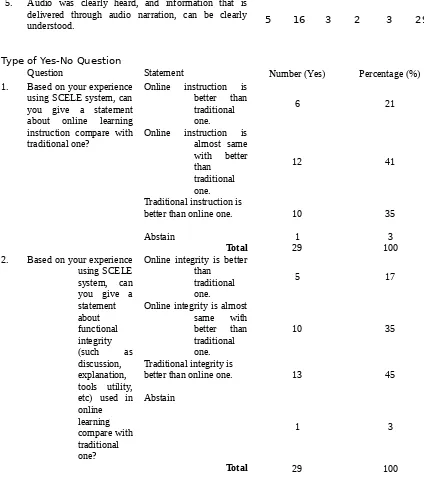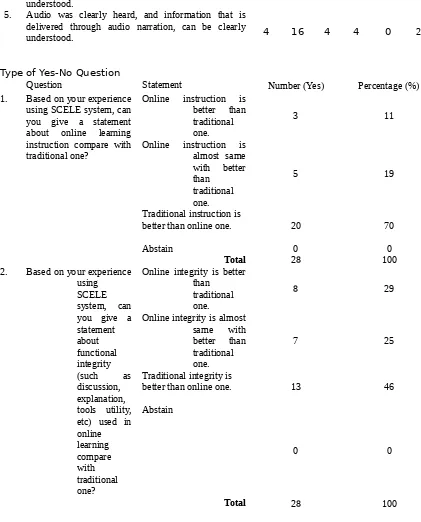Issues and Strategies to Develop Learning Management System and Content Development 1)
Zainal A. Hasibuan
Faculty of Computer Science University of Indonesia [email protected]
Abstract
Faculty of Computer Science, University of Indonesia (Fasilkom-UI) experiences the development of Student Centered E-Learning Environment (SCELE) as A Learning Management System (LMS), and Contents that are conform to SCELE. This study addressed several issues and strategies concerning the development, implementation, deployment, and evaluation of the systems. A holistic approach of methodology is used to develop the systems. Supporting systems, such as Online Academic Information Systems and Digital Library are also integrated in this SCELE. Combinations of online delivery and face-to-face teaching and learning method enhanced the quality of e-learning. Legal aspects and endorsements from the authority should be provided. Preliminary evaluation results show that the e-learning systems can be used to enhance the conventional teaching and learning. Future work is to deliver this e-learning system for credit earning program toward a degree programs.
I. INTRODUCTION
E-Learning system with all its advantages is able to attract many parties, not only from education sector but also from business sector. According to LTSN Generic Centre, these followings are some advantages that e-learning system has [1]:
1. Flexibility. E-learning system provides a wider opportunity to learner to study at any time and any place.
2. Access. Improving the flexibility means improving access to information,
regardless time and place.
3. Communication. E-learning system is able to facilitate and provides opportunity
in order to develop a learning community.
4. Access to information. E-learning system can e integrated with and facilitates the
learner to obtain various e-journal and e-books.
5. Access to services. E-learning system is able to help education institution to
improve its services and improve the efficiency in administration.
These advantages lead to the widespread use of e-learning system as a complementary system to conventional system of teaching and learning.
Basically, e-learning system consists of two main components. Firstly, Learning Management System (LMS) that can be defined as a system that organize how learning activities can be done by using any facilities, such as user administration, courses
management, communication tools, both synchronous and asynchronous, etc. We have developed LMS at Faculty of Computer Science, University of Indonesia (Fasilkom, UI) by modifying Moodle (Modular Object Oriented Dynamic Learning Environment). Secondly, Content Development, that is an activity that conducted to produce course material that ready to be delivered in the e-learning system. Content development process needs cooperation and collaboration between teacher as course expert, instructional designer as someone who has expertise in learning design, and developer as someone who have expertise to create e-learning course materials.
In order to make both components optimally in action into a working system, they should be combined with a student-centered learning paradigm. Otherwise the system will be absent of its pedagogical aspect.
II. STUDENT-CENTERED LEARNING PARADIGM
Currently, Faculty of Computer Science (Fasilkom) University of Indonesia (UI) has developed e-learning system by using student-centered approach that is called Student Centered E-Learning Environment (SCELE) [4]. The focus of this e-learning system is on student with characteristics of student-centered as follows:
Student encouraged being active in learning process and teacher has role as a
facilitator to guide any learning activities.
Student can create their own steps to achieve lesson goals based on teacher’s
guidelines.
Social interaction (discussion) is very important to get any knowledge in this
learning environment. Student can enrich their understanding about some topics by discussing (asking and answering question) it with other students and the teacher.
According to [2] student-centered learning has definition:
“Student-centered learning describes ways of thinking about learning and teaching that emphasize student responsibility for such activities as planning learning, interacting with teachers and other students, researching, and assessing learning.”
By using this definition, we believe that the system we developed, students can meet new learning experience and can exercise active and collaborative learning. In this case, the teacher’s role is changing from prime actor into facilitator or mediator in order to guide learning process [3]. Before learning activities adopt student-centered paradigm, most of them implement teacher-centered. This old one, has an assumption that teacher is an expert who knows everything, as communicate by Michael Clark (2004):
teacher-centered environment, student viewed me as the “expert” who had all the answers”.
By using teacher-centered approach, it is indicated that the students are easier to be more passive learner as compare to be an active students and they tend to wait any ‘supply’ from teacher. Having this student-centered approach in mind, then it should be reflected in strategies of content development.
III. E-LEARNING CONTENT DEVELOPMENT ROADMAP
It is realized that during the developing content, the ability of students are varies. Some of them are already having strong basic knowledge about course materials at studied, and some of them those course materials are totally new to them. In order to accommodate this discrepancy, we develop course materials in various levels of presentations. Beside that, we also incorporate several supporting materials such as:
1. Textbook
We believed that in order to carry out student-centered learning, we have to lessen the dependency of students to their teacher. In a conventional learning, teacher becomes the main reference to the students. Students can interact directly (face-to-face/synchronous) with the teacher. However, in e-learning environment, the teacher and the students can reside in a different place and get to the system in a different time. The communication will take place asynchronously. In order to narrow the gap of perception, the teacher and the students should have the same references. Hence, the availability of the textbooks is important. Beside that, the textbooks need to accompany by rich case studies with a clear instructional manual.
2. Syllabus Table and Graph
The Table of Syllabus and Subject Graph is another thing that the teacher has to provide. It is mandatory that a teacher has to plan its course materials and presented in a syllabus. The syllabus provides detailed sessions and the objective of each session (see table 1). The syllabus has to be accompanied with subject graph that will assist students moving from one topic to another topics. The graph will maintain the relationship among the sessions.
(a) Table Course
No Session Nam e Related Chapter Session Objectives Topics Key Concepts
(b) Table Course Topic
No Topic Name Topic Objectives Sub Topics Types of Media Related Material Assesment
(c) Table Assessment
Table 1. Syllabus Table
From table 1, it can be shown that the syllabus table consists of three parts. First part is the table of course materials. It explains the materials in each session. If we compare to traditional teaching and learning, this part is similar to material that should be capitalized by students every week. The second part is the detail about the topic of course material found in the first part. The last part is the assessment table that explained on how assess the topic that occur in the second part.
[image:4.612.182.517.425.686.2]This syllabus table can be used as a guidance to content developer in order to suit into the SCELE. Based on this syllabus table also, the content developer can develop directed graph that can be used by student in learning. The directed graph consists of course graph and assessment graph. Course graph represented course table where each node representing session (see Figure 2). Specifically, there are types of nodes: node that only related to course material in a chapter of the textbook (one-to-one relation) and node that related to more than one chapters of the textbook (one-to-many relation). This graph can be used by the students as a learning roadmap and also can play as tools to provide feedback. This roadmap is really convenient to the students in order to support student-centered learning.
This course graph is accompanied with assessment graph becomes the guidance to the content developer (see Figure 3).
Figure 3. Assessment Graph
3. Course Materials
In order to accommodate various levels student understanding, it needs develop content that conform to such situation. In this case we develop course materials in three consecutive levels:
1. Course Materials Level 1:
Course materials in this level are simply in the form of power-point file. These materials are intended to students who are already very knowledgeable about the topic, but they still want to browse the materials quickly. We developed material in this level by providing pointers and trigger the student to find more information by providing clear references.
2. Course Material Level 2:
Course material in level 2 is enriched with rich media, such as providing Narration to the materials. Narration can be in the form of audio, animation, graph, video, and notes. These enriched materials can be considered as the explanation of the teacher in traditional learning.
Course material level 3 consists of materials that are not necessary related to the textbook but contain of the knowledge material background that can provide value added to the material. In the SCELE, the placement of this level course material is not related to level 1 and 2. The materials can be accessed from all courses.
IV. SCELE AND CONTENT EVALUATION
In order to evaluate the use of course material for our e-learning purpose, we have held trial activities. The students who participated in the evaluation activities are from Graduate Program in Information Technology students at Faculty of Computer Science, University of Indonesia. We have evaluated the use of Computer Networked and Data Communication and Information System Analysis and Design course materials. Respondents who participated in this evaluation came from various groups of age. We also get data that consists of 14% respondents were female, 82% were male, and 2% respondent was anonym for total 28 students set involved for Information System Analysis and Design course and 29 students for Computer Networked and Data Communication (14% respondents were female, 69% respondents were male, and 17% respondents were anonym).
From the questionnaire results, we know that, in general, respondents said that SCELE system is worth to be implemented for distance learning (see Table 2-4). Most of respondents agree that course materials, which are provided through SCELE, can be clearly understood. Animations were indicated clear, and information, which is delivered through those animations, can be clearly understood by 72% respondents (answered by students who take Computer Networked and Data Communication course) and 68% respondents who take System Analysis and Design course. Similar percentage, for about 72% respondents in that classes said that audio was clearly heard, and information, which is delivered through audio narration, can be clearly understood.
Table 2. Questionnaires result for Computer Networked and Data Communication Course
Type of Agree-Do Not Agree Question
No Statement A+ A DA DA+ ABS Total
1. SCELE system is worth to be implemented for
distance learning 14 12 3 0 0 29
2. You can focus on learning all the time while other students and instructor were discussing by using SCELE
3 12 5 2 7 29
3. Course materials, which are provided through SCELE,
4. Animations were indicated clear, and information that is delivered through those animations, can be clearly understood.
5 16 3 2 3 29
5. Audio was clearly heard, and information that is delivered through audio narration, can be clearly
understood. 5 16 3 2 3 29
Type of Yes-No Question
Question Statement Number (Yes) Percentage (%) 1. Based on your experience
using SCELE system, can you give a statement about online learning instruction compare with traditional one?
Online instruction is better than traditional one.
6 21
Online instruction is almost same with better than
traditional one.
12 41
Traditional instruction is
better than online one. 10 35
Abstain 1 3
Total 29 100
2. Based on your experience using SCELE system, can you give a statement about functional integrity (such as discussion, explanation, tools utility, etc) used in online learning compare with traditional one?
Online integrity is better than
traditional one.
5 17
Online integrity is almost same with better than traditional one.
10 35
Traditional integrity is
better than online one. 13 45
Abstain
1 3
[image:7.612.89.513.110.589.2]Total 29 100
Table 3. Questionnaires result for System Analysis and Design Course
Type of Agree-Do Not Agree Question
No Statement A+ A DA DA+ ABS Total
1. SCELE system is worth to be implemented for
distance learning 17 9 2 0 0 28
2. You can focus on learning all the time while other students and instructor were discussing by using SCELE
3. Course materials, which are provided through SCELE,
can be clearly understood 2 22 3 0 0 28
4. Animations were indicated clear, and information that is delivered through those animations, can be clearly understood.
4 15 8 1 0 28
5. Audio was clearly heard, and information that is delivered through audio narration, can be clearly
understood. 4 16 4 4 0 28
Type of Yes-No Question
Question Statement Number (Yes) Percentage (%) 1. Based on your experience
using SCELE system, can you give a statement about online learning instruction compare with traditional one?
Online instruction is better than traditional one.
3 11
Online instruction is almost same with better than
traditional one.
5 19
Traditional instruction is
better than online one. 20 70
Abstain 0 0
Total 28 100
2. Based on your experience using SCELE system, can you give a statement about functional integrity (such as discussion, explanation, tools utility, etc) used in online learning compare with traditional one?
Online integrity is better than
traditional one.
8 29
Online integrity is almost same with better than traditional one.
7 25
Traditional integrity is
better than online one. 13 46
Abstain
0 0
[image:8.612.90.511.121.643.2]Total 28 100
Table 4. Questionnaires answer instruction
No Abbreviation Explanation
1 2
A+ A
3 4 5
DA DA+ ABS
Do not agree
Do not agree (in advance) Abstain
V. Conclusion
We have learned various aspects need to be considered in order to deliver quality teaching and learning using e-learning system.
1. Firstly, the learning activity on each topic has to have a defined and limited time in order to discuss. The pace of learning of the student is not the same. Hence, the e-learning system is still needs a consolidation with a face-to-face mode. This is inline with various suggestions that e-learning system cannot be used alone, it has to combine with traditional mode.
2. The result of the test case, it shown that the use of e-learning system can be shortened the student learning curve. This is happened due to the availabity the course materials anytime at anywhere. The student who cannot join the facto-face or want to reply what has been discussed, she or he can always get on the e-learning system.
3. We conclude that the e-learning system is not a replacement of traditional learning but instead it is a complementary to the traditional system. We found out the expression presented during the traditional learning cannot be replaced with in e-learning system.
4. In the future, we will develop and experiment the use of sound background in order to make the learning materials more alive.
5. We also at the stage to deliver e-learning system to remote campuses of another higher education institution by empowering local tutor.
VI. References
[1] M. Jenkins and J. Hanson, e-Learning Series: A guide for Senior Managers, United Kingdom, LTSN Generic Centre, August 2003.
[2] R. Cannon, Guide to support the implementation of the Learning and Teaching Plan Year 2000, ACUE, The University of Adelaide, 2000.
[3] M.B. Tinzmann, B.F. Jones, T.F. Fennimore, J. Bakker, C. Fine, and J. Pierce, What Is the Collaborative Classroom? [On-line], Available:
http://www.ncrel.org/sdrs/areas/rpl_esys/collab.htm, 6 April 2005.
[5] Hasibuan, Zainal A., and Wisnu M. Suryaningrat. “ An Integration of Digital Library: Case Study University of Indonesia’s Library”. IADIS International Conference 2004. Avila, Spain.



